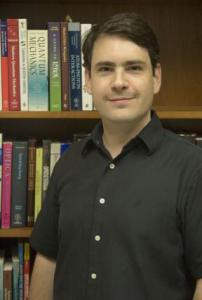Jul 28 2014
A University of Oklahoma physicist has received a $1 million grant from the W.M. Keck Foundation to develop a quantum enhanced plasmonic sensor.
 Alberto Marino
Alberto Marino
The emerging field of physics known as quantum plasmonics will enable technology for sensing applications and lead to earlier detection of diseases, detection of pathogens that were previously 'invisible,' and advanced warning of dangerous pollutants or chemicals in the atmosphere.
"The proposed project merges different fields of research, making it unique and even more valuable, as its applicability goes beyond the field of Atomic, Molecular and Optical Physics," said OU President David L. Boren. "In addition, it opens the doors to collaboration with Oak Ridge National Laboratory, which will greatly benefit both the Homer L. Dodge Department of Physics and the University of Oklahoma," he said.
Albert Marino, assistant professor in the Homer L. Dodge Department of Physics and Astronomy, OU College of Arts and Sciences and the project's principal investigator, will collaborate on the four-year project, Quantum Enhanced Plasmonic Sensors, with Raphael Pooser, Oak Ridge National Laboratory and the University of Tennessee. Pooser developed a quantum plasmonics program at Oak Ridge National Laboratory and has worked with Marino on other related projects.
Marino and Pooser's groundbreaking idea will result in an ultra-sensitive sensing device with the potential to revolutionize a number of fields and dramatically improve the detection and identification of chemical, biomolecules and changes in atmospheric pressure. The practical applications of this technology include the ability to characterize chemical and biological agents in extremely small quantities with minimal error—in contrast to the hours of processing today.
"We will go beyond the current state-of-the-art by combining quantum states of light with novel plasmonic sensors to obtain a sensitivity enhancement of several orders of magnitude," states Marino.
"Traditional plasmonic sensors are used to detect local changes in air pressure or traces of biomolecules and chemicals, but they are approaching their ultimate sensitivity."
One of the most important benefits of this research is the potential to bring quantum enhanced sensors to practical applications in the fields of chemistry, medicine and atmospheric science. The quantum enhanced plasmonic sensor proposed will serve as proof of principle for a new practical sensor class based on quantum states of light.